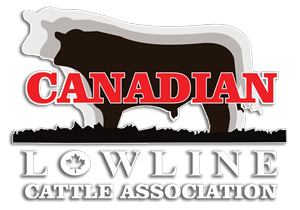FREQUENTLY ASKED QUESTIONS ABOUT THE LOWLINE BREED
Q: Where did Lowline cattle come from?
A: Lowlines were developed from a dwarf free herd of 100% Registered Angus, which was established at the Trangie Research Cente in Australia in 1929 to provide quality beef breeding stock for the New South Wales industry. From that early beginning and after decades of selection to moderate frame size came this exciting beef breed we call Lowlines. See a more thorough history
Q: Are Lowlines miniature cattle?
A: No, Lowlines are true beef cattle in a compact smaller frame size. They are well proportioned 100% Angus heritage, beef cattle that are naturally polled and docile animals. They have no dwarfism traits and were bred with an emphasis on weight gain and conformation; Lowlines are well suited to beef production on grass and because of their lower maintenance costs, are more efficient converters of grass to meat than today’s larger breeds.
Q: What size are they?
A: Average size mature cows generally weigh about 650 to 950 pounds and stand from 36 to 42 inches at the shoulder. Average size mature Lowline bulls weigh from 950 to 1350 pounds and stand from 39 to 46 inches. The average birth weight of fullblood calves is 42 to 52 pounds.
Q: Do they calve easily?
A: Yes, due to the smaller size of a newborn calf, assistance is not generally required at calving time and Lowline cows make excellent mothers.
Q: Do Lowlines require special handling facilities?
A: No, Lowlines don’t require expensive handling facilities. Being naturally polled and docile, they make for easier handling. They are an excellent choice for those just getting started in the cattle business.
Q: Do they have special feed requirements or environmental limitations?
A: Lowlines thrive on smaller amounts of feed, whether grass or hay because of their efficient conversion of grass to meat. Lowlines require limited amount of feed and this makes them ideal for smaller acreage and allows for more Lowlines to be stocked in the same area that would support traditional cattle. Rotational grazing more numbers of smaller animals on a property creates more hoof action that is beneficial to implanting seeds to reestablish grasses and legumes in sensitive areas. This makes Lowlines a better choice for riparian areas as well as arid or sandy soils. Being of true Angus, they adapt well to all weather conditions and climates as is demonstrated by the wide variety of Lowline members located in different areas of the country.
Q: What impact can Lowlines make in the commercial industry?
A: Given their feed requirements for a commercial operation there are less inputs, higher stocking rates and more rib eye area per 100 pounds of carcass weight. A 3 year study, where Lowline bulls were used on commercial heifers, that ended in 2006 by North Dakota State University, Dickinson Research Extension Center came to this conclusion for the commercial industry “The halfblood Lowline steers average weight for the three year study was 1221 lbs., 51-52 inches at the hip, and brought 92 cents per pound average. “These bulls produce small calves that grow.”
Q: Where can I see Lowline cattle?
A: Go to the Membership page where you’ll find breeders in almost every province. Most members are more than happy to show you their Lowline cattle. On the Events page, you’ll find shows and other events where you can also see Lowline cattle as well as visit with breeders.
Q: What are the benefits of Lowline cattle?
A: Lowline cattle are easy calving, good natured cattle that are very feed efficient and maintain themselves on grass. They have excellent taste, texture and tenderness beef characteristics and exceptional ribeye area per hundred pounds of body weight which translates to very high yielding, high quality, high value beef carcasses.
Lowlines answer the challenges of both the large scale rancher and the small acreage farmers.
For the large scale ranch operation, Lowlines lower labor and veterinary costs and provide many economic advantages. Commercial heifers bred to fullblood Lowline bulls calve easily and breed back quickly, reducing the calving interval. Halfblood Lowline cows maintain themselves on about half the feed that is required by a full size crossbred cow and wean more pounds of calf per acre.
Lowlines are also a perfect choice for small acreage farmers. Their small size makes them easy to handle and minimizes equipment requirements. Their feed efficiency improves the carrying capacity of a farm. They produce exceptional quality beef. They are ideal show animals for 4-H and other youth projects bringing in the next generation of cattle people. They may also offer the tax advantages of an agriculturally based property and business.
Lowline cross cattle are extremely well suited to grass-fed beef production as they are easy fleshing and will finish on a high roughage ration, producing high value carcasses with a minimum of input costs.
